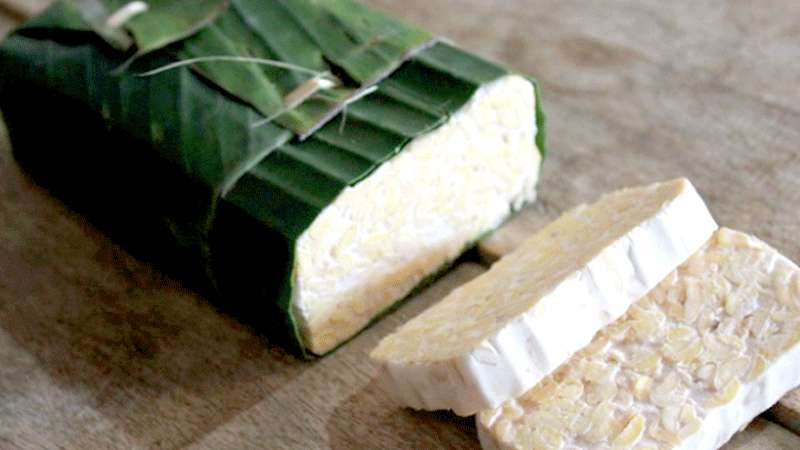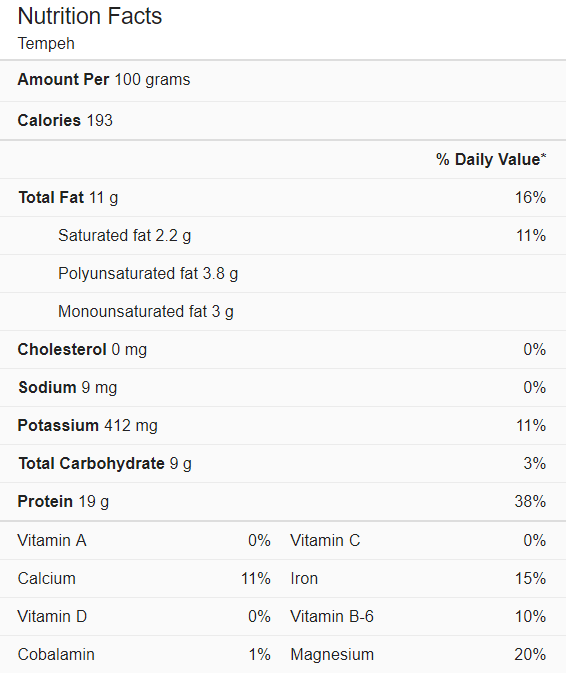Deep-fried, sautéed or steamed, tempeh is one of the most versatile ingredients in Indonesian cooking. It is one of the signature dishes in Indonesia that is not available anywhere else in the world, so it is a #musttry for you to try while in Indonesia.
What is Tempeh?

Originating from Java, Tempeh is fermented soybeans bound into cake form. Similar to tofu, it is made of soybean product although it has a firmer texture due to the inclusion of the whole bean, rather than softer variety. This would also mean that every bit of nutrition contained in the soybean from protein, dietary fiber, and vitamins are still maintained to be eaten.
Tempeh is favored for its firm, earthy flavor that is versatile enough to be made into any kind of dish. The flavor gets more pronounced over time.
The exact timing for its discovery is a mystery, where the earliest record of tempeh appeared in 1815 in the Serat Centhini. It is believed that tempeh is the result of Chinese immigrants who stayed in Java during the 17 century. Chinese Indonesian Ong Hok Ham suggests that tempeh was an accident resulting from the tofu industry in Java. At that time, it was found that the spores of white fungus that appeared on the tempeh were found to be edible.
Tempe can be easily bought at any wet market, roadside vegetable vendors and high ened super markets in Indonesia. It very affordable.

Make Tempeh!
Fortunately, Tempeh is fairly easy to make in your home.
Ingredients:
2 Cups of soybean
6 cups of water
2 Tbsp vinegar
2 pinches of starter
Vented ziplock bags
How to make tempeh:
- Put soybean in a bowl and pour water. Soak overnight.
- Manually remove the skin of beans. This should be fairly easy as the skin has already separated from the bean itself.
- Boil the beans for 45 minutes. Remove the remaining skin by discarding the floating bits.
- Spread the beans on a sieve and wipe using dry cloth.
- Mix in vinegar and starter, then mix well.
- Create vented Ziploc bags by poking holes for air to pass through.
- Put the beans into the Ziploc bag. Afterwards, you can store in a warm place for 24-60 hours.
- The appearance of solid white in the bags means that the tempeh is done.

You can now cook and serve the processed tempeh!

There are many ways to cook tempeh ranging from making it into gorengan variety, make it spicy or even crispy fried tempeh.
Health Benefits of Tempeh
Tempeh is not only delicious but it is also highly nutritious for anyone to eat. Benefits vary from the digestive system, cardiovascular health, bone and much more. In fact, health specialists have proclaimed that it contains as much protein as beef and contains more wholesome nutrition than tofu.
A whopping 19 gms of protein/100 gms of tempeh!

source: Wikipedia
Here are the health benefits of Tempeh:
1. Balances blood sugar
Manganese is also one of the things that are contained in Tempeh, which would affect the conditions of the body. Eating just one serving already satisfied 54 percent of the body’s minimum requirement of manganese, where you will be able to get the nutrition you need by eating the delicious food. Several ways that it can affect your body from synthesis of nutrients like cholesterol, carbohydrates and proteins. Increased bone mass, the balance of hormones are also some of the effects of manganese.
Those suffering from diabetes can also maintain their blood sugar levels with the manganese found in Tempeh. First, it helps the proper production of digestive enzymes that is responsible for gluconeogenesis. This process is crucial as it involves the conversion of amino acids in protein to sugar and keeping the balance of sugar within the bloodstream. Second, it helps with increasing insulin secretion, which manages blood sugar levels and improves glucose intolerance.
2. Increases metabolic support
As been said above, tempeh contains both beneficial nutrients riboflavin and niacin. Tempeh fulfills 55 percent of the recommended daily amount for women and 46 percent for men. Other than that, it fulfills 31 and 28 percent of the recommended daily amount for women and men. In congruence, these vitamins activate enzymes for the cellular metabolism system to work.
Riboflavin vitamin is also known to maintaining eye and skin health, while niacin controls your appetite.
3. Controls Blood Pressure
Soy is rich in Iron, calcium and potassium. Compared to other vegetables, potassium absorption in soy is particularly higher. For that reason, the high content of potassium would therefore make soy more useful to maintain number of high blood pressure.
Magnesium contained in tempeh plays an important role on the cardiovascular system. It is known to prevent blood clots and lower blood pressure.
4. Boosts bone health
On the other hand, calcium elements present in Tempeh aid a variety of body parts. The heart, gut and bone health can be maintained. Calcium is essential to maintaining and promoting bone health, making it stay strong from fractures and brittle bones. Any damage can even be healed with the right amount of calcium intake. Your teeth will also be maintained, as it maintains bone density and helps bones heal.
The presence of copper also helps in maintaining bone density and strength. Copper helps brittle bones prone to breaking, osteoporosis, low strength and muscle weakness. Research mentions that the amount of copper in the body affects rate of bone healing, maintenance and repair of tissue.
5. Rich in probiotics
As with any fermented food, tempeh is rich in probiotics. This creates a protective lining in the body that protects the body from pathogens (E. Coli, Salmonella, etc) and increases the amount of gut bacteria. A protected digestive system with good amount of gut bacteria will result in bacteria that is easier controlled within the gut. Ailments such as diarrhea, indigestion, chronic inflammation and even lowered immune system are some of the things you can fix.
6. Lowers cholesterol
Soy isoflavones contained in tempeh are said to be beneficial to decrease the total amount of LDL cholesterol in the body. This is very important as LDL cholesterol creates blockages to the arteries, increasing the chances of a stroke. Niacin found in soy is also said to be effective in controlling cholesterol levels in the body. Heart medications usually contain Niacin because of its properties to lower cholesterol levels and can increase levels of beneficial HDL cholesterol.
7. Reduce symptoms of menopause
Those experiencing menopausal can also experience benefits from consuming tempeh. Research has suggested that the isoflavones found in tempeh can provide relief to those experiencing menopause. From keeping blood cholesterol levels in check, reducing the number and incidence of hot flashes.
8. Provides muscle building protein
Other than beef and chicken meat, tempeh is also something that contains nearly the same amount of protein for about 16 grams in a three ounce serving. Amino acid converted from protein during the fermentation process is also able to reduce the amount produced by the gut. Not only that, but protein is also responsible for other things in our body from keeping our metabolism running, increasing energy and keeping blood sugar stable. Amongst other things, protein supports neurological function, aids in digestion, balances hormones and helping you maintain an upbeat mood.
9. May have anticancer properties
Soy isoflavones are said to have impressive anti-inflammatory properties. Antioxidants are said to fight free radicals and help prevent inflammation to protect cells against damage. The body experiences a reduced risk of illnesses such as heart disease, diabetes and cancer.
Some research has even found that soy isoflavones could be effective in blocking cancer growth and development as well by decreasing estrogen synthesis and altering metabolism from damaging to being inactive.
Amongst all Indonesian food, tempeh is one of the signature ingredient in any Indonesiasn’s daily meal. Its ability to be made into various kinds of food is what makes it popular and easy to be found in any Indonesian restaurant. For that reason, tempeh is one food stuff that you must try when visiting in Indonesia. Whether it is in gorengan form, grilled or baked, you will find that tempeh is delicious every which way.




